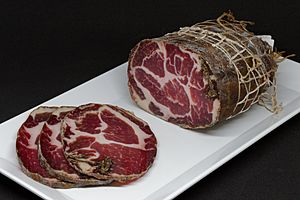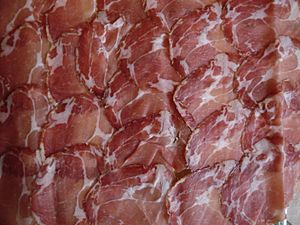Capocollo facts for kids

A Capocollo
|
|
| Alternative names | Coppa |
|---|---|
| Course | Antipasto |
| Place of origin | Italy |
| Region or state | Emilia-Romagna Puglia Calabria Basilicata Lazio Toscana Umbria Marche Campania Molise Abruzzo Veneto Sardegna |
| Associated national cuisine | Italian Cuisine |
Capocollo (pronounced kap-oh-KOH-loh) is a yummy traditional Italian and Corsican food. It is also known as coppa (pronounced KOH-pah). It's a type of cold cut made from pork. This special meat comes from the neck and shoulder area of a pig.
Capocollo is made by a process called dry-curing. This means the meat is preserved using salt and spices, not cooked. It's similar to ham or prosciutto, which are also popular pork cold cuts. Capocollo is usually sliced very thin. People enjoy it in many different dishes.
Contents
What is Capocollo Called?
This delicious pork cold cut has different names. In most parts of Italy, it's called capocollo or coppa. The name capocollo comes from two Italian words: capo meaning "head" and collo meaning "neck".
In some areas like Campania and Calabria, people call it capicollo. In Corsica, it's known as capicollu. Outside of Italy, in places like Argentina, Paraguay, and Uruguay, it's called bondiola or bondiola curada. In North America, you might hear it called capicola or capicolla.
Sometimes, Italian Americans in the Northeastern United States say "gabagool". This is a special way of saying capocollo that developed over time.
How is Capocollo Made and Used?
Making capocollo is a careful process. First, the meat is lightly seasoned. People often use red or white wine, garlic, and different herbs and spices. The exact spices can change depending on the region.
Next, the meat is salted. Traditionally, it was also massaged. Then, it's put into a natural casing. After that, it's hung up to cure for up to six months. Sometimes, hot paprika is rubbed on the outside before it's hung.
Capocollo is known for its amazing flavor and soft, slightly fatty texture. It is often more expensive than other cold cuts. Many people consider it a special food.
You can find capocollo in places where there are large Italian communities. It's usually sliced thinly. People often eat it as an antipasto, which is a starter dish before a meal. It's also great in sandwiches like muffulettas, Italian subs, and panini. Some traditional Italian pizzas also use capocollo.
Different Kinds of Capocollo
Some types of capocollo have special protection under European Union law. This means only capocollo made in specific regions can use these names. Two examples are Coppa Piacentina and Capocollo di Calabria. This ensures the quality and origin of the product.
Italy also has five other regions that make capocollo. These are recognized by the Italian government as "traditional food products." They include:
- Capocollo della Basilicata;
- Capocollo del Lazio;
- Capocollo di Martina Franca: This type comes from Apulia. It is smoked using special ingredients like laurel leaves, thyme, almonds, and Mediterranean herbs. It also uses bark from a tree called Macedonian Oak. People often eat it with figs.
- Capocollo tipico senese or finocchiata, from Tuscany;
- Capocollo dell'Umbria;
Outside of Europe, Italian immigrants brought capocollo to Argentina. There, it is known as bondiola or bondiola curada.
Images for kids
See also
 In Spanish: Capicola para niños
In Spanish: Capicola para niños



